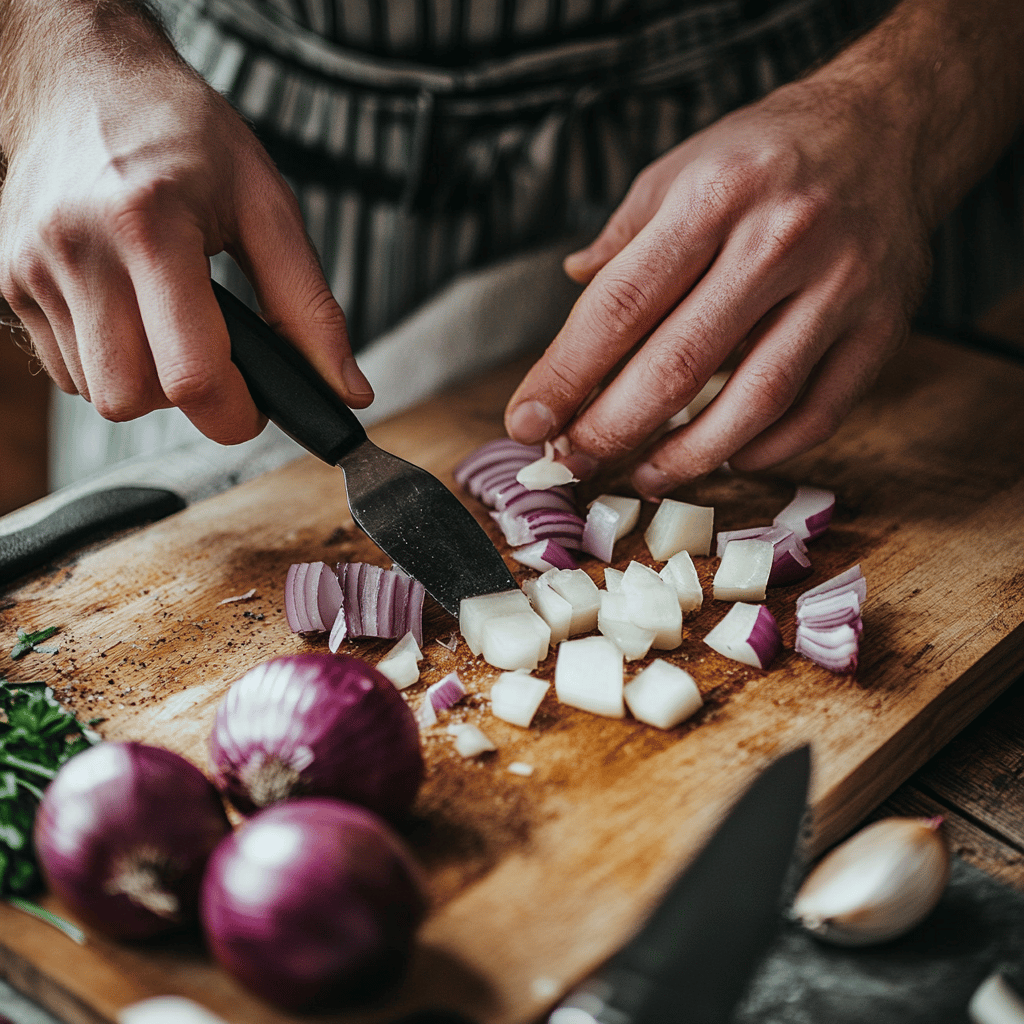The Best Fluffy Pancakes recipe you will fall in love with. Full of tips and tricks to help you make the best pancakes.

The Best Chefs Agree: This Is How to Dice an Onion Without Crying
Chopping onions can evoke tears, but it doesn’t have to be a disheartening experience. Learn effective techniques and tips from professional chefs to dice onions like a pro—without the tears!
Introduction
Onions are a staple in kitchens around the globe, adding flavor to countless dishes from hearty soups to savory pasta. However, many home cooks dread the simple act of chopping them due to the watery eyes and discomfort they often induce. Thankfully, there’s good news! Mastering the art of dicing onions can not only save your eyes from tears but also enhance your cooking skills. In this comprehensive guide, we will delve into the science behind why onions make us cry, explore tips and techniques for minimizing tears, and walk you through the step-by-step process to achieve perfectly diced onions. Get ready to revolutionize your onion chopping experience!
Understanding Why Onions Make You Cry
The tears that onions provoke aren’t just a surprise! They stem from a chemical reaction that occurs when you cut an onion. Here’s a quick breakdown:
The Chemistry Behind the Tears
- Alliinase Enzyme: When you cut an onion, you break its cells, releasing an enzyme called alliinase.
- Pyruvan-ric Acid: Alliinase reacts with sulfur-containing compounds released, creating sulfuric acid.
- Tear Production: This acid irritates the eyes, leading to tears as a protective response.
It’s a fascinating chemical reaction, but it leaves many home cooks tearing up over their cutting boards. Understanding this process can help you strategize effective methods for minimizing those tears.
Essential Tools for Dicing Onions
Stocking your kitchen with the right tools can drastically refine your onion-dicing skills. Here’s what you’ll need:
- Sharp Knife: A well-sharpened chef’s knife is essential. It helps to cleanly cut through the onion without crushing its cells.
- Cutting Board: Buy a sturdy, large cutting board with grooves to catch any juices.
- Onion Goggles: Consider using goggles specifically designed for chopping onions. They can provide an extra layer of protection.
- Food Processor (optional): If dicing by hand is still too much for you, a food processor can make quick work of dicing onions without tears.
Techniques for Dicing Onions Without Tears
Here are several tried-and-true techniques from expert chefs to help you dice onions without shedding a tear:
1. Chill Your Onions
Before you start chopping, place your onions in the refrigerator for about 30 minutes. The cold temperature slows down the activity of the enzymes that trigger tearing, making the process less painful.
2. Cut Near a Vent or Open Window
Fumes released while cutting onions can irritate your eyes. Dicing your onions near a kitchen vent or an open window can help dissipate these irritants.
3. Use a Sharp Knife
A dull knife may crush the onion instead of slicing cleanly, releasing more tears. A sharp knife will cut through more easily, minimizing cell damage and therefore reducing the sulfuric compounds released.
4. Breathe Through Your Mouth
Some chefs swear by breathing through your mouth instead of your nose while chopping. This technique reduces the inhalation of onion vapors, helping stave off tears.
5. Cut Underwater
This method may not be practical for everyone, but if the mess doesn’t bother you, cutting onions submerged in water prevents the sulfuric acid gases from reaching your eyes.
6. Use Vinegar or Lemon Juice
Before you chop, consider rubbing the onion’s surfaces with vinegar or lemon juice. The acidity can help neutralize the enzyme before you cut into the onion.
The Step-by-Step Guide to Dicing an Onion
Ready to dive into dicing? Here’s a straightforward guide to do it like the pros:
Step 1: Preparation
Gather your tools. Place a sharp knife, cutting board, and the onion on a clean countertop. Remove any outer skin from the onion.
Step 2: Trim the Ends
- Cut off the top (the pointed end) of the onion, leaving the root end intact. The root contains a higher concentration of the tear-inducing chemicals.
- Peel away the papery skin, exposing the onion layers.
Step 3: Cut in Half
Place the onion cut-side down on the board for stability. Cut it in half from the root to the top.
Step 4: Vertical Cuts
With each half of the onion flat on the board, make several vertical cuts from the top towards the root. Make these cuts close together to achieve smaller dice.
Step 5: Horizontal Cuts
Rotate the onion and make horizontal cuts across the onion. The closer together these cuts are, the finer the dice will be.
Step 6: Final Small Cuts
Finally, dice finely by slicing perpendicular to your previous cuts while being careful to retain the root end, which keeps everything together as you finish chopping.
Tips for Different Onion Types
Not all onions are created equal! Depending on the type of onion you are using, you may need to adjust your approach:
Yellow Onions
- Most versatile and commonly used for cooking. Their sweetness intensifies with cooking.
- Perfect for sautéing, soups, and stews.
Red Onions
- Typically milder and slightly sweeter, these are great for salads and garnishes.
- Prepare to experience less tearing due to their lower sulfur content.
White Onions
- Sharp and pungent in flavor, these are often used in Mexican cuisine.
- These can elicit more tears than yellow onions, so consider chilling them before dicing.
Green Onions
- Also known as scallions, they have a milder flavor with a crunchy texture.
- Dicing them involves slicing the green tops and the white bulbs separately for diverse flavor profiles in dishes.
Onion Storage Tips
Understanding how to store your onions properly can also help maintain their freshness and minimize tear-inducing reactions:
Whole Onions
- Store in a cool, dry, and dark location (like a pantry). Avoid refrigeration as it can cause them to sprout.
Cut Onions
- Wrap tightly in plastic wrap or store in an airtight container. Refrigerate for up to a week.
- Be mindful that cut onions can absorb and emit odors, so keep them away from other foods.
Creative Ways to Use Diced Onions
Now that you’ve mastered dicing onions, it’s time to put them to good use! Here are some delicious recipes to try:
- Mushroom Pasta – A creamy delight featuring your perfectly diced onions.
- Cheesy Tater Tots – Perfect as a party appetizer, enhanced with diced onions for more flavor.
- Chicago-style Potatoes – A comforting baked dish integrating diced onions for a savory depth.
Conclusion
Chopping onions doesn’t need to make you cry—it can even be an enjoyable task with the right techniques and tools! By understanding the science behind why onions make us weep and applying expert methods to minimize tears, you can enhance your culinary skills. So grab those onions, put these tips into practice, and transform your cooking experience. And remember, if you liked this, check out Savory 20-Minute Shrimp Bake for more delicious meal ideas that can benefit from your newfound cutting skills!





